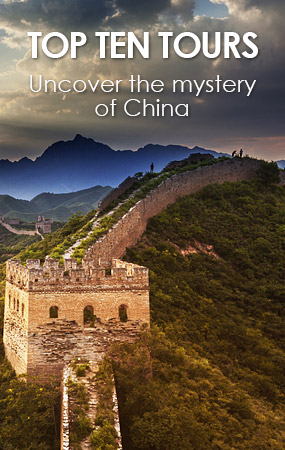Chinese Tea
According to Lu Yu, the writer of the book Tea Classics in the Tang Dynasty, Chinese tea enjoyed a more than 4000 years history.
Tea was used as offerings in the Western Zhou, vegetables in the Spring and Autumn period, and medicine in the Warring period. Later in the Western Han Dynasty, it became a main commodity. During 300 years between the Three Kingdoms period and the Northern and Southern Dynasties, especially the latter, Buddhism was popular and Buddhists applied tea to relieve sleep in za-zen, so tea trees spread along valleys around temples.  That is why people say tea and Buddhism accompanied each other in their development. Till the Tang dynasty tea became popular in ordinary people. In the Ming dynasty, tea trade began to play an important role in the government economy, the "Tea and Horse Bureau" was set up to supervise the tea trade.
That is why people say tea and Buddhism accompanied each other in their development. Till the Tang dynasty tea became popular in ordinary people. In the Ming dynasty, tea trade began to play an important role in the government economy, the "Tea and Horse Bureau" was set up to supervise the tea trade.
In the 6th century, a Buddhist monk introduced tea to Japan and in the 16th century to Europe by a Portuguese missionary. And tea became an international drink.
Now in China, tea family not only consists of traditional tea, but also tea beverage, tea food, tea medicine and other tea products.
Tea Classification
Although there are hundreds of varieties of Chinese tea, they can be mainly classified into five categories, that is, green tea, black tea, brick tea, scented tea, and Oolong tea.
With its natural fragrance, green tea, as the oldest kind of tea, is widely welcomed by different people. It is baked immediately after picking. According to the different ways of processing, it can be divided to many kinds. 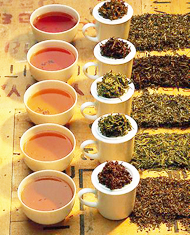 Among various green tea, Longjing (Dragon Well) Tea around the WestLake in Hangzhou, HuangshanMaofeng Tea from Mt.Huangshan, Yinzhen (Silver Needle) Tea from Mt.Junshan and Yunwu (Cloud and Mist) Tea from Mt.Lushan are most famous.
Among various green tea, Longjing (Dragon Well) Tea around the WestLake in Hangzhou, HuangshanMaofeng Tea from Mt.Huangshan, Yinzhen (Silver Needle) Tea from Mt.Junshan and Yunwu (Cloud and Mist) Tea from Mt.Lushan are most famous.
Black tea is much more favored by foreigners. Different from green tea, black tea is a kind of fermented tea. After the fermentation, its color changes from green to black. The most famous black teas in China are " Qi Hong (originated in Anhui), "Dian Hong"(originated in Yunnan), and "Ying Hong" (originated in Guangdong).
Oolong tea, with an excellent combination of the freshness of green tea and the fragrance of black tea, become popular with more and more people. It has a good function in helping body building and dieting. Fujian, Guangdong and Taiwan are the major producing areas of this kind of tea. Oolong tea grows on cliffs, the hard picking process make it the most precious tea.
Scented tea, which is very popular in Northern China, in fact is a mixture of green tea with flower petals of rose, jasmine, orchid and plum through an elaborate process. Among this type, jasmine tea is common.
Brick tea, usually pressed into brick shape, is mainly produced in Hunan, Hubei, Sichuan, Yunnan and Guangxi Zhuang Autonomous Region. Brick tea is made from black tea or green tea and is pressed into blocks. This kind of tea is popular with minority people in border regions. The most famous one is "Pu'er Tea" made in Yunnan province.
There are other kinds of tea. Among them white tea is special and is not very familiar to most people. Just as its name suggests, this kind of tea is as white as silver. It is mainly produced in Zhenhe and Fuding in FujianProvince, but popular in Southeast Asia. Famous varieties include "Silver Needle" and "White Peony".
Tea Wares
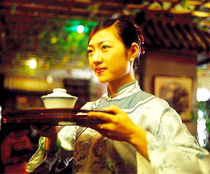 In China, people think different teas prefer different tea wares. Green tea prefers glass tea ware, scented tea porcelain ware while Oolong tea performs best in purple clay tea ware.
In China, people think different teas prefer different tea wares. Green tea prefers glass tea ware, scented tea porcelain ware while Oolong tea performs best in purple clay tea ware.
In its long history, tea wares not only improve tea quality but also by-produce a tea art. Skilled artisans bestow them artistic beauty.
Tea wares consist of mainly teapots, cups, tea bowls and trays etc. Tea wares had been used for a long time in China. The unglazed earthenware, used in Yunnan and Sichuan provinces for baking tea today, reminds us the earliest utensils used in ancient China. Tea drinking became more popular in the Tang dynasty when tea wares made of metals were served for noblesse and civilians commonly used porcelain ware and earthenware. In the Song dynasty tea bowls, like upturned bell, became common. They were glazed in black, dark-brown, gray, gray/white and white colors. Gray/white porcelain tea wares predominated in the Yuan dynasty and white glazed tea wares became popular in the Ming dynasty. Teapots made of porcelain and purple clay were very much in vogue during the middle of the Ming dynasty. Gilded multicolored porcelain produced in Guangzhou, Guangdong Province and the bodiless lacquer wares of FujianProvince emerged in the Qing dynasty. Among various kinds of tea wares, porcelain wares made in Jingdezhen, Jiangxi Province and purple clay wares made in Yixing, Jiangsu Province occupied the top places.
Nowadays, tea wares made of gold, silver, copper, purple clay, porcelain, glass, lacquer and other materials are available.
Tea Culture
China is known as the home town of tea. People throughout the country drink tea daily. Because of the geographic location and climate, different places grow various kinds of tea. In general, there are five kinds of tea classified according to different technique involved in the making of tea. They are Longjin of Hangzhou, Wulong of Fujian, Jasmine tea, Black tea and compressed tea.
The most conspicuous content in China's tea culture is the popular phrase---Ke Lai jin Cha--when a guest arrives, a cup of tea will be brewed for him." In the past dynasties, people not only formed a special way of Tea-drinking, but also developed an art form called tea-drinking. This art form comprises of many aspects. The most noticeable ones are the making of tea, the way of brewing, the drinking utensils such as tea pot.
Tea drinking is so popular in every part of the country that there is a museum specially dedicated to the tea culture in China. It is located in Hangzhou, the hometown of Longjin Tea (dragon well tea). In Hangzhou, there is a tea museum, the only national museum of its kind. In it, there are detailed description of the historic development of tea, making and brewing methods and the like.
Just as coffee in the West, tea became a part of daily life in China. You can see teahouses scattered on streets like cafes in the west. It has such a close relationship with Chinese that in recent years, a new branch of culture related to tea is rising up in China, which has a pleasant name of "Tea Culture". 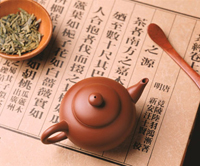 It includes the articles, poems, pictures about tea, the art of making and drinking tea, and some customs about tea.
It includes the articles, poems, pictures about tea, the art of making and drinking tea, and some customs about tea.
In the Song dynasty, Lu You, who is known as "Tea Sage" wrote Tea Scripture, and detailedly described the process of planting, harvesting, preparing, and making tea. Other famous poets such as Li Bai, Du Fu and Bai Juyi once created large number of poems about tea. Tang Bohu and Wen Zhengming even drew many pictures about tea.
Chinese are very critical about tea. People have high requirements about tea quality, water and tea wares. Normally, the finest tea is grown at altitudes of 3,000 to 7,000 feet (910 to 2,124m). People often use spring water, rain and snow water to make tea, among them the spring water and the rainwater in autumn are considered to be the best, besides rainwater in rain seasons is also perfect. Usually, Chinese will emphasis on water quality and water taste. Fine water must feature pure, sweet, cool, clean and flowing.
Chinese prefer pottery wares to others. The purple clay wares made from the Yixing, Jiangsu province and Jingdezhen, Jiangxi province are the best choice.
In China, there are customs about tea. A host will inject tea into teacup only seven tenth, and it is said the other three tenth will be filled with friendship and affection. Moreover, the teacup should be empty in three gulps. Tea plays an important role in Chinese emotional life.
Tea is always offered immediately to a guest in Chinese home. Serving a cup of tea is more than a matter of mere politeness; it is a symbol of togetherness, a sharing of something enjoyable and a way of showing respect to visitors. To not take at least a sip might be considered rude in some areas. In previous time, if the host held his teacup and said "please have tea", the guest will take his conge upon the suggestion to leave.
How to Select Excellent Tea
Selecting tea is a subject of knowledge.
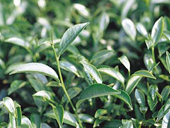
Aside from the variety, tea is classified into grades. Generally, appraisement of tea is based on five principles, namely, shape of the leaf, color of the liquid, aroma, taste and appearance of the infused leaf.
Speaking of the shape of the leaf, there are flat, needle-like, flower-like, and so on. The judgment is usually made according to the artistic tastes of the tea tasters.
The evenness and transparency of the leaf will decide the color of the liquid. Excellent liquid should not contain rough burnt red leaves or red stems.
Aroma is the most important factor in judging the quality of a kind of tea. Putting 3 grams leaves into 100 milliliters boiled water, people can judge the quality of the tea by the smell from the liquid.
The judgment should be completed through the taste of the liquid and the appearance of the infused leaves.
10 Best Chinese Teas
Longjing (Dragon Well): Produced at Longjing village near the West Lake, Hangzhou, Zhejiang.
Biluochun: Produced at Wu County, Jiangsu.
Huangshanmaofeng: Produced at Mt.Huangshan in Anhui.
Junshan Silver Needle: Produced at QingluoIsland on DongtingLake.
Qimen Black Tea: Produced at QimenCounty in Anhui.
Liuan Guapian: Produced at LiuanCounty in Henan.
Xinyang Maojian: Produced at Xinyang, Henan.
Duyun Maojian: Produced at Duyun Mountain, Guizhou.
Wuyi Rock Tea: Produced at Wuyi Mountain, Fujian.
Tieguanyin: Produced at Anxi County, Fujian.

